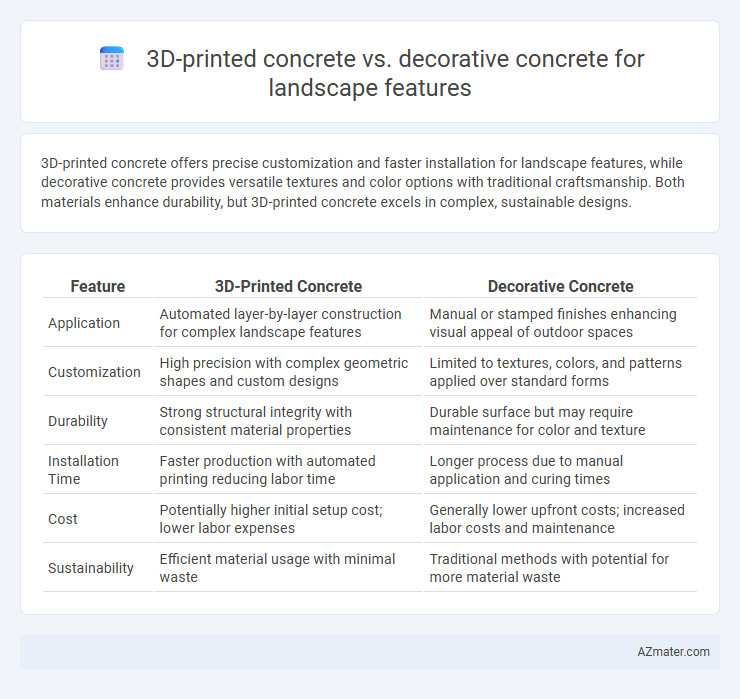3D-printed concrete offers precise customization and faster installation for landscape features, while decorative concrete provides versatile textures and color options with traditional craftsmanship. Both materials enhance durability, but 3D-printed concrete excels in complex, sustainable designs.
Table of Comparison
| Feature | 3D-Printed Concrete | Decorative Concrete |
|---|---|---|
| Application | Automated layer-by-layer construction for complex landscape features | Manual or stamped finishes enhancing visual appeal of outdoor spaces |
| Customization | High precision with complex geometric shapes and custom designs | Limited to textures, colors, and patterns applied over standard forms |
| Durability | Strong structural integrity with consistent material properties | Durable surface but may require maintenance for color and texture |
| Installation Time | Faster production with automated printing reducing labor time | Longer process due to manual application and curing times |
| Cost | Potentially higher initial setup cost; lower labor expenses | Generally lower upfront costs; increased labor costs and maintenance |
| Sustainability | Efficient material usage with minimal waste | Traditional methods with potential for more material waste |
Introduction to 3D-Printed Concrete and Decorative Concrete
3D-printed concrete utilizes advanced additive manufacturing technology to create intricate, highly customizable landscape features with precise layering and reduced waste. Decorative concrete, on the other hand, employs traditional casting and finishing techniques such as stamping, staining, and polishing to enhance texture and aesthetic appeal in outdoor environments. Both methods offer unique advantages in design flexibility and durability for landscaping projects.
Material Composition and Properties
3D-printed concrete utilizes a specialized blend with added polymers and accelerators to achieve rapid setting times and enhanced tensile strength, allowing intricate, durable landscape features to be fabricated layer by layer. Decorative concrete incorporates pigments, sealers, and aggregates in traditional mixes, focusing on aesthetics such as color variation and texture while maintaining standard compressive strength. The material composition of 3D-printed concrete offers superior structural integrity and design flexibility compared to the more visually driven but mechanically conventional decorative concrete.
Design Flexibility and Aesthetics
3D-printed concrete offers unparalleled design flexibility by enabling complex, custom shapes and intricate textures that traditional decorative concrete cannot easily achieve. While decorative concrete provides a wide range of surface finishes and color options, 3D printing allows for precise, layered construction that can integrate organic or futuristic forms seamlessly into landscape features. This advanced technology enhances aesthetic possibilities by combining structural innovation with detailed artistic expression, making it ideal for unique, visually striking outdoor installations.
Installation Speed and Workflow
3D-printed concrete significantly reduces installation time by automating the layering process, enabling rapid and precise construction of complex landscape features compared to the labor-intensive traditional decorative concrete methods. The workflow for 3D-printed concrete integrates CAD modeling and robotic extrusion, minimizing manual labor and errors, while decorative concrete requires skilled artisans for shaping, texturing, and finishing on-site. This technological advancement streamlines project timelines, decreases labor costs, and enhances consistency in outdoor installations.
Cost Considerations and Budgeting
3D-printed concrete offers cost savings in labor and material efficiency due to automated layering, making it suitable for budget-sensitive landscape features. Decorative concrete typically involves higher labor costs and longer installation times, increasing overall expenses for intricate designs. Budgeting should account for initial setup costs with 3D printing technology versus the detailed craftsmanship required for traditional decorative concrete finishes.
Durability and Longevity in Outdoor Settings
3D-printed concrete exhibits superior durability and longevity in outdoor settings due to its precise layering technique that reduces micro-cracks and enhances structural integrity. Decorative concrete, while aesthetically versatile, often requires frequent sealing and maintenance to withstand weathering and UV exposure. The advanced material composition and controlled deposition of 3D-printed concrete significantly extend the lifespan of landscape features compared to traditional decorative concrete finishes.
Environmental Impact and Sustainability
3D-printed concrete significantly reduces material waste and carbon emissions by using precise layering techniques and optimized mix designs, making it a sustainable option for landscape features. Decorative concrete often involves additional coatings and dyes that may contain volatile organic compounds (VOCs), increasing environmental concerns and reducing recyclability. The longevity and minimal maintenance of 3D-printed concrete further contribute to its lower environmental footprint compared to traditional decorative concrete methods.
Customization Potential for Unique Landscape Features
3D-printed concrete offers unparalleled customization potential for unique landscape features, enabling intricate designs and complex geometries that traditional decorative concrete cannot easily achieve. This technology allows precise layering and texture variations, making it ideal for bespoke elements such as sculptural walls, planters, and seating. Decorative concrete, while versatile in color and pattern, is limited by mold shapes and manual application, restricting the scope of customization compared to 3D printing.
Maintenance Requirements and Long-term Care
3D-printed concrete offers precise layering that reduces surface imperfections, resulting in lower maintenance requirements compared to traditional decorative concrete, which may require more frequent sealing and repairs due to susceptibility to cracks and stains. The durable composition of 3D-printed concrete enhances its resistance to weathering and erosion, ensuring better long-term performance for landscape features. Decorative concrete demands regular upkeep, including cleaning, resealing, and possible touch-ups to maintain aesthetics, while 3D-printed structures benefit from minimal intervention and extended service life.
Suitability for Various Landscape Applications
3D-printed concrete offers precise customization and complex geometric designs ideal for unique, contemporary landscape features such as sculptural walls and intricate planters. Decorative concrete excels in versatility and aesthetic appeal for traditional applications including stamped patios, textured walkways, and stained driveways, blending seamlessly with natural surroundings. Both materials provide durability and weather resistance, but 3D-printed concrete is better suited for innovative, tailored projects while decorative concrete aligns with classic, cost-effective landscaping needs.

Infographic: 3D-printed concrete vs decorative concrete for landscape feature
 azmater.com
azmater.com